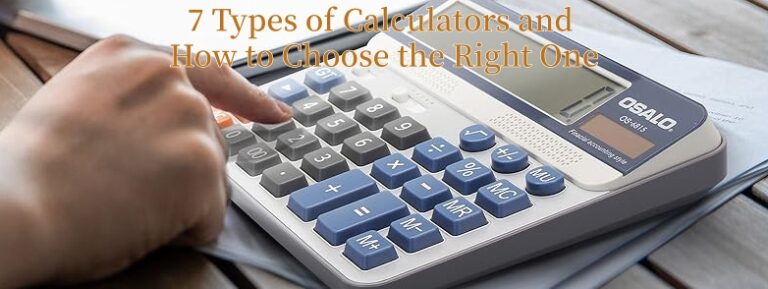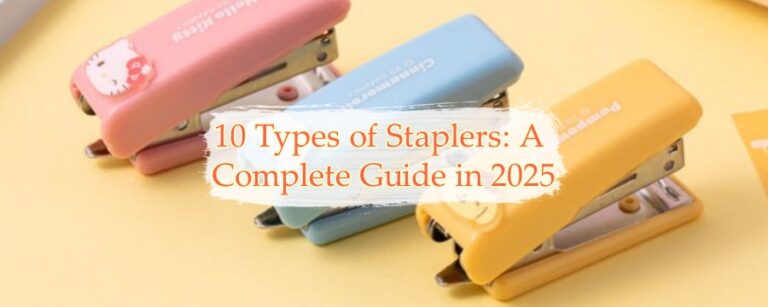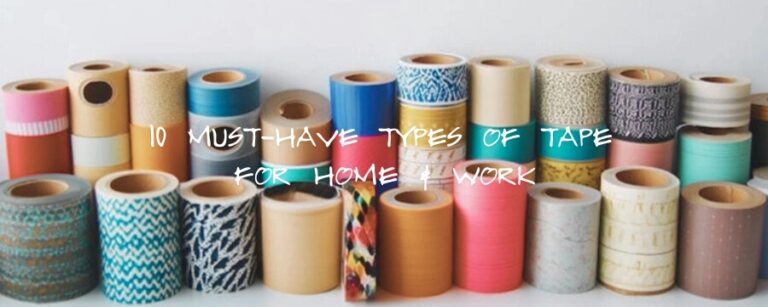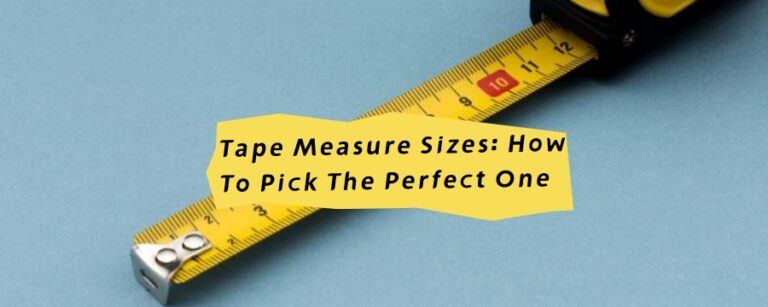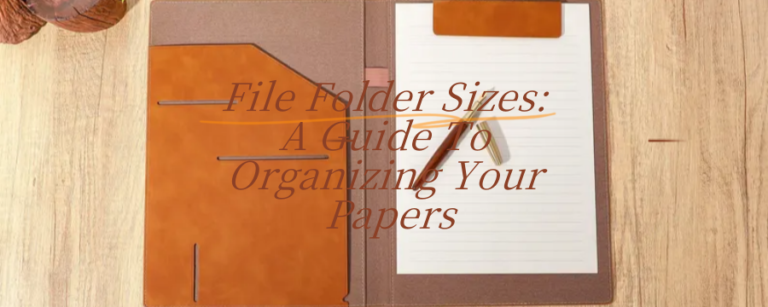introduction
In the realm of correspondence, an envelope transcends its role as a mere paper container—it serves as the first impression of your message, a guardian of vital documents, and a canvas for creative expression.
Dating back centuries, this flat paper pouch has evolved from a simple folded sheet to a sophisticated utility.
Today, types of envelopes come in a diverse range of materials, sizes, and designs, each meticulously tailored to specific needs—whether for securing important files, making a stylish statement, or enabling functional communication.
Paper Choices for Different Types of Envelopes
The function and texture of an envelope start with the choice of paper. Different materials have their advantages and disadvantages, from durability to aesthetics, which profoundly affect the user experience. Next, we will show you the key points of paper selection.
1. Kraft Paper
- Features: It is a natural paper, usually light brown or gray, with a rough surface, and has a unique environmental protection and retro feel.
- Weight: Most kraft paper envelopes weigh about 100g/m², suitable for most general purposes
- Applicable scenarios: Environmental theme letters, handicrafts, art invitations, small business, or personalized letters.
2. Coated paper
- Features: It is a specially coated paper with a smooth and glossy surface and a good printing effect.
- Weight: The common weight is 150g/m² to 250g/m².
- Applicable scenarios: high-end business envelopes, holiday greeting cards, event promotional materials, and brand promotion.
3. Recycled paper
- Features: Made from recycled paper, this product is environmentally friendly.Rough texture, darker color.
- Weight: Common weight is 100 g/m² to 120 g/m².
- Applicable scenarios: Environmental protection event promotion envelopes, environmental protection brand letters, and corporate social responsibility activities.
4. Transparent paper
Features: It is a translucent paper with a unique visual effect that can show part of the letter content.
Weight: The common weight is 70g/m² to 90g/m².
Applicable scenarios: Fashion brand invitations, art exhibitions, and creative custom envelopes.
5. Linen paper
Features: The surface has fine lines similar to linen fabric, and you can feel the soft and bumpy texture when you touch it.
Weight: Generally between 120g/m2 and 250g/m2. Commonly used weights are 150g/m² or 200g/m².
- Applicable scenarios: high-end wedding invitations, luxury brand envelopes, environmental protection theme activities, or brands.
6. Woodfree Paper
- Features: It is a high-quality paper without sawdust and has a smooth surface, suitable for general printing tasks. It has good stability and can maintain durability for a long time.
Weight: The common weight is 90g/m² to 110g/m².
Applicable scenarios: Daily office letters, letters from government and educational institutions, and ordinary business envelopes.
In addition to the above 6 types of paper, there are many other types of paper, such as inkjet paper, photo paper, tissue paper, etc. If you want to know more about the types of paper, click: 20 Different Types of Paper and Uses: The Ultimate Guide.
Lorem ipsum dolor sit amet, consectetur adipiscing elit. Ut elit tellus, luctus nec ullamcorper mattis, pulvinar dapibus leo.
Types of Envelopes by Closure Methods
-768x768.jpg)
1. Self-adhesive strips
- Features: Built-in self-adhesive strips, just tear off the protective film and press to seal, easy to operate, suitable for quick sealing. It has strong viscosity and will not open easily after sealing.
- Applicable scenarios: daily business letters, advertising, financial documents, and internal company mail.
.jpg)
2. water glue
- Features: Usually uses more environmentally friendly adhesive materials, environmentally friendly. If it is opened after sealing, it will leave obvious traces, safe and tamper-proof.
- Applicable scenarios: Formal business letters, legal documents, and contracts, private letters.
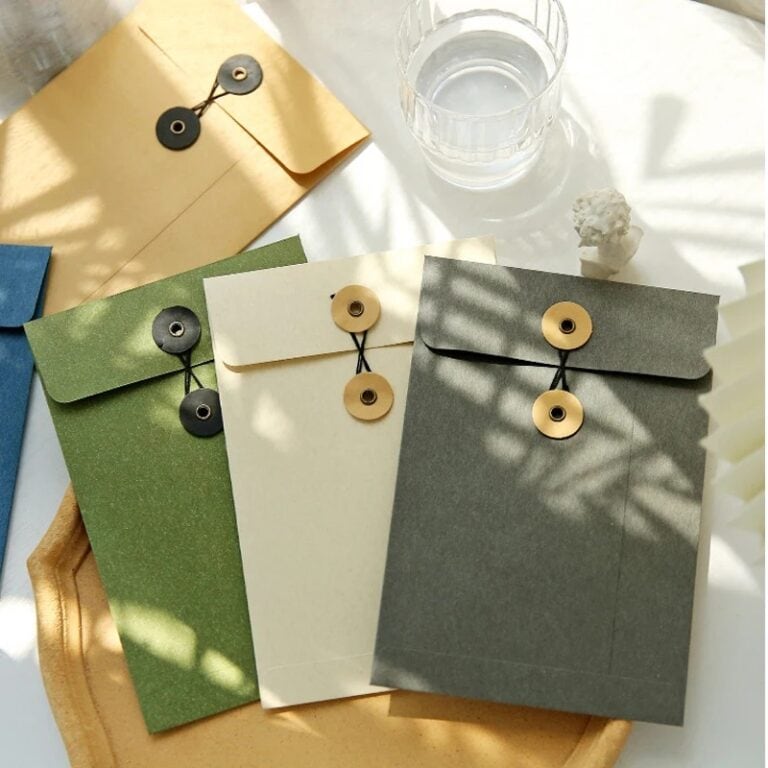
3. Button cord buckle
- Features: The seal is completed by wrapping the cord around the button and fastening it. It can be opened and closed repeatedly without damaging the envelope, allowing the recipient to look through the contents multiple times while preserving the integrity of the envelope.
- Applicable scenarios: high-end invitations, important business documents, and collection packaging.
.jpg)
4. Ribbon closure
- Features: It is a decorative sealing method, using a ribbon or silk ribbon to tie up the envelope. Suitable for letters or envelopes with higher requirements, it can add a romantic and elegant atmosphere to the envelope.
- Applicable scenarios: cultural and creative gift market, celebration etiquette scene, and high-end business field.
Scene Selection: Types of Envelopes for Occasions
Different usage scenarios require completely different types of envelopes in terms of function and design.
Choosing the right type of envelope can not only ensure the safe delivery of items but also add a sense of ceremony and professionalism to the content.
The following will introduce the characteristics and applications of various envelopes in detail for typical scenarios such as office mail, holiday cards, invitations, etc.
1. Office Mail Envelope
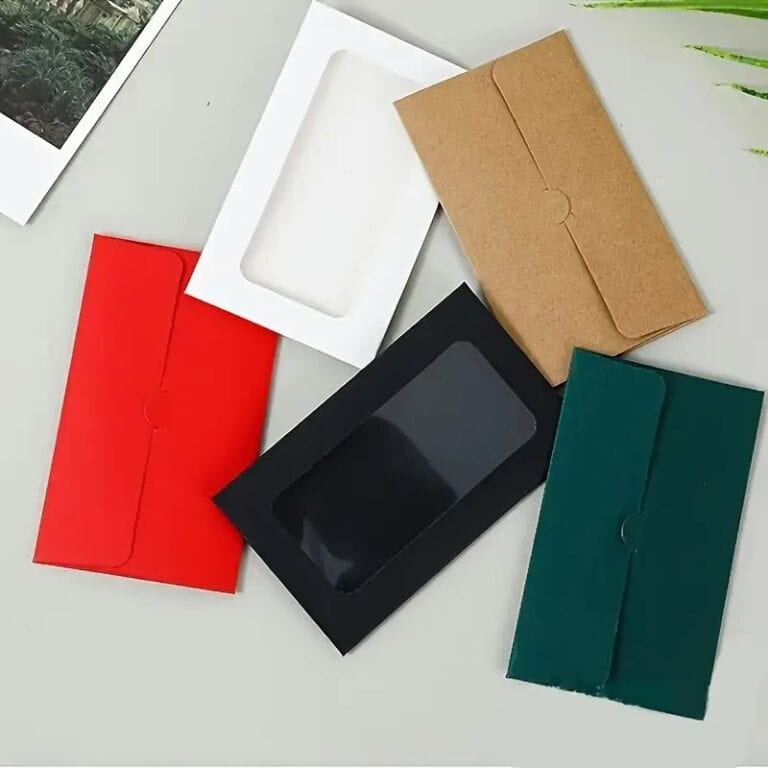
Window envelope:
- Features: It has a transparent window to display the address inside. It is suitable for bills, notices, short letters, etc., saving printing costs and improving mailing efficiency.
Envelope size: DL (110mm x 220mm), C5 (162mm x 229mm), C4 (229mm x 324mm).
- Window size and position: Usually, the window size is 90mm x 40mm, located on the left or right side of the envelope.
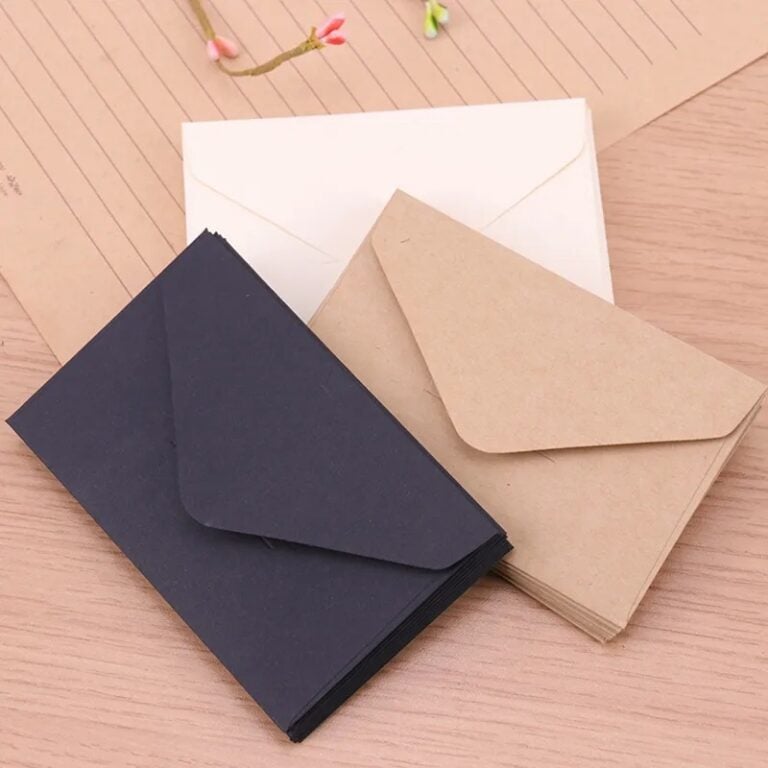
Windowless envelope:
- Features: It is often used for impersonal business letters or documents that need privacy protection. It is suitable for daily office mail.
- Size: DL (110mm x 220mm), C5 (162mm x 229mm), C4 (229mm x 324mm), B4 (250mm x 353mm).
2. Holiday Card Envelopes
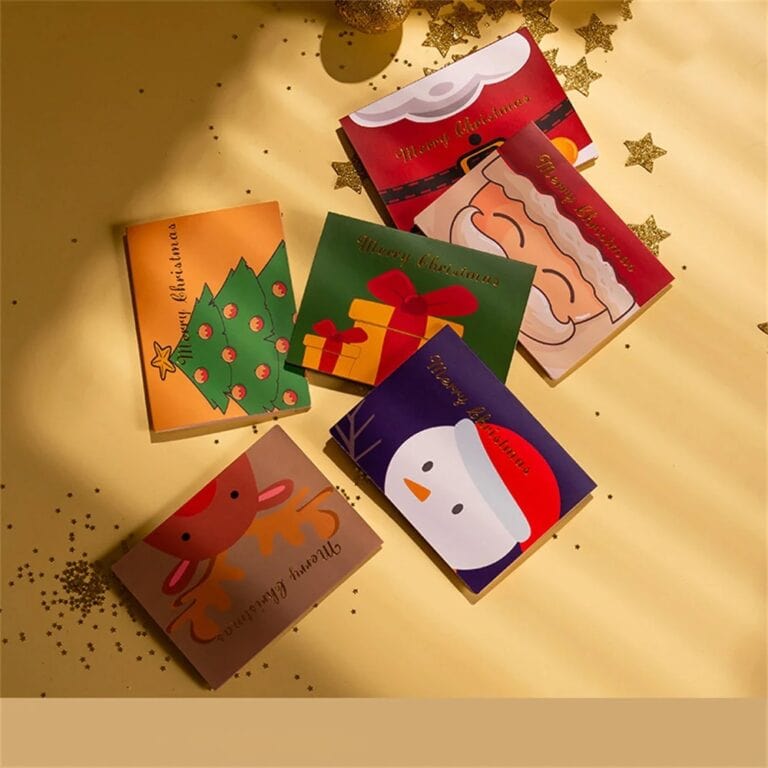
- Features: Holiday card envelopes are designed for holidays such as Christmas, Spring Festival, Valentine’s Day, etc., and usually have special decorations and designs to highlight the festive atmosphere.
- Size: Common sizes are 105mm x 148mm or 130mm x 180mm, suitable for greeting cards and small gift packaging.
3. Invitation envelope
-768x717.jpg)
- Features: The design is exquisite, and sometimes special materials or decorations are used, which give a higher sense of quality. It is often used in important social occasions such as weddings, company activities, annual meetings, business meetings, etc.
- Size: The common size is C6 (114mm x 162mm), suitable for wedding invitations, conference invitations, etc.
4. Folder Envelope
-768x768.jpg)
- Features: The thicker paper provides extra support to prevent the document from being bent or damaged during mailing. It is used for mailing larger documents, such as contracts, documents, samples, etc.
- Size: Commonly used are large-size envelopes such as A4 and C4, suitable for storing large documents or folders.
5. Electronic product packaging envelope
-768x768.jpg)
- Features: Made of durable paper or plastic material, often with foam padding or bubble film to prevent damage to the product during transportation.
- Size: Customized according to the size of the electronic product, usually small or medium envelopes, suitable for mailing electronic products such as mobile phones and headphones.
6. Small envelope
.jpg)
- Features: The size is exquisite and it is usually suitable for small-sized objects, such as business cards, notes, small greeting cards, stamps, etc. It can make efficient use of space and avoid waste of resources or inconvenience in carrying caused by overly large envelopes.
- Size: Common sizes are small envelopes such as 90mm x 60mm, 100mm x 70mm, etc.
Other key considerations
When choosing types of envelopes, in addition to the basic material and scene adaptation, many details are easy to overlook but crucial. From cost control to environmental responsibility, from privacy protection to special scene requirements, these hidden factors often determine the final effect of the envelope.
- Weight and postage: Thicker materials may increase postage, so it is recommended to choose lightweight envelopes for international mailing.
- Environmental certification: Choose envelopes with FSC certification or biodegradable materials to contribute to environmental protection.
- Security design: Anti-peep windows, tamper-proof seals and other designs protect privacy and document security.
- Special uses: Bubble envelopes are shock-resistant and pressure-resistant, and waterproof envelopes are suitable for humid climates. International mailing must meet aviation standards.
Now that you understand envelope papers, types, and selection criteria, you likely need a supplier who delivers both quality and variety.
As a professional stationery manufacturer, we specialize in envelopes for every need—from heavy-duty durability to convenient self-sealing designs.
Our product line, including Customized Envelopes for unique requirements, ensures the perfect match for your scenario, elevating your documents with professionalism and precision
FAQ
Will window envelopes leak privacy?
Choosing envelopes with frosted film or offset window design can effectively prevent information leakage.
How to prevent envelopes from deforming in humid environments?
Choose envelopes with moisture-proof lining or PVC coating to avoid moisture damage.
Are all envelopes suitable for the printer?
Be sure to choose products marked “printer compatible” to avoid paper jams or ink blurring.
How to choose envelopes when sending international letters?
It is recommended to use lightweight kraft paper material, which is resistant to wear and tear during long-distance transportation.
If you want to learn more about how to choose the right envelope based on the standards, we recommend reading Standard Envelope Sizes and Styles: Your Complete Guide.




